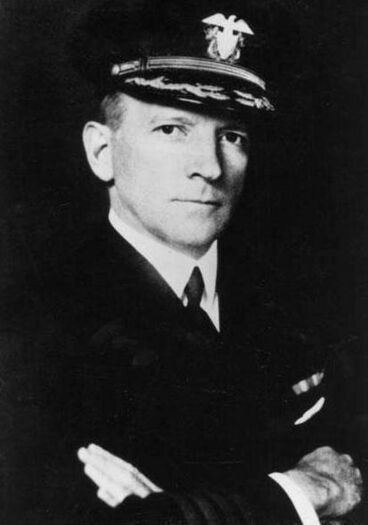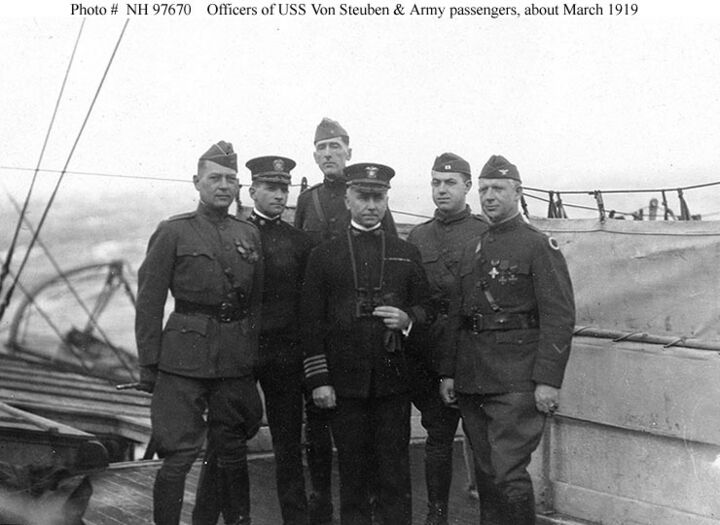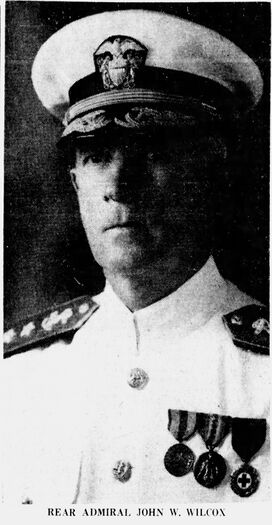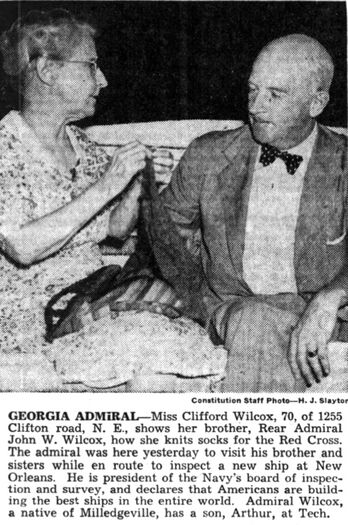JOHN W. WILCOX, JR., RADM, USN
John Wilcox, Jr. '05
Lucky Bag
From the 1905 Lucky Bag:
John Walter Wilcox
Macon, Georgia
"Billie" "Bill Pecker"
Cheerful as a summer's day and is successful in everything except the Math. Department; especially the ladies who can not with stand his modesty, grace and his expert skating. Special champion of the Junior social set. So polite that he will laugh obligingly even at Tommy's bum jokes. Beloved alike by both young and old and can make a chaperon think he is a theological student in a ten-minute sitting. "I'll break your face if you call me a ladies' man!"
Three Stripes (1) Buzzard (2) Secretary of Athletic Association (2) Chairman Farewell Ball Committee (2) Hop Committee (3, 2, 1) Class Crest Committee, Class Baseball Team (2) Captain (3) Second Baseball Team (4) Hustlers (4, 3) Football Team (2, 1) Lightweight Wrestling (2) Gym Team (4) Rifle Team (2) Santee (2) Indiana (4) Tribunal.
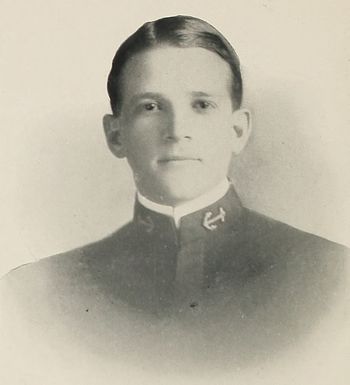
John Walter Wilcox
Macon, Georgia
"Billie" "Bill Pecker"
Cheerful as a summer's day and is successful in everything except the Math. Department; especially the ladies who can not with stand his modesty, grace and his expert skating. Special champion of the Junior social set. So polite that he will laugh obligingly even at Tommy's bum jokes. Beloved alike by both young and old and can make a chaperon think he is a theological student in a ten-minute sitting. "I'll break your face if you call me a ladies' man!"
Three Stripes (1) Buzzard (2) Secretary of Athletic Association (2) Chairman Farewell Ball Committee (2) Hop Committee (3, 2, 1) Class Crest Committee, Class Baseball Team (2) Captain (3) Second Baseball Team (4) Hustlers (4, 3) Football Team (2, 1) Lightweight Wrestling (2) Gym Team (4) Rifle Team (2) Santee (2) Indiana (4) Tribunal.
Loss
John was lost on March 27, 1942 when he fell overboard from USS Washington (BB 56) while transiting the North Atlantic Ocean. He was the commanding officer of Task Force 39.
Other Information
From researcher Kathy Franz:
In November 1941, John told a reporter how he first fell in love with the sea. “As a youth he was visiting a friend in Charleston one day when a great Navy battlewagon steamed in. He and his chum got a small rowboat and paddled out to the ship. A kindly officer took the lads aboard, showed them around the vessel, and sent them back ashore with the captain's gig towing the bateau. Thrilled by the waterfront, young John then resolved to be a sailor man.” Per The Atlanta Journal, April 7, 1942.
John graduated from Gresham high school in Macon in 1901.
He was appointed to the Naval Academy by Congressman Charles L. Bartlett. At the football game between West Point on November 28, 1903, Ralph Strassburger ('05) was not doing well as quarterback, and John went in. However, West Point won the game 40-5. John was chairman of the Farewell Ball for the Naval Academy Class of 1904. At graduation in 1905, John was presented a silver and pearl mounted revolver by the company that he captained.
His summer of 1907 was spent in Japanese and Chinese waters engaged in target practice. The ship returned in September to San Francisco from Chefoo, China.
In May 1908, John played left field on the baseball team for the battleship West Virginia. They won against the Washington University club in Seattle. In August, he was at Camp Perry in Ohio. With him were Willis A. Lee ('08) and Carl Osburn ('07). The camp held its second annual rifle tournament with the Navy winning second place.
In June 1909, American Red Cross funds under the superintendence of American naval officers were used to rebuild houses destroyed by the Italian earthquake at Reggio and Messina. Among the officers was John. They were based at Constantinople.
In April 1917, John volunteered to give a class on navigation to various yacht clubs members in New York City. He was a member of the St. Nicholas club, and his course was on navigating small vessels when on soundings. The course was done over ten weeks and included piloting, dead reckoning, charts and their uses and corrections, the compass, compass error and its determination, the log, and the lead.
John married Caroline Manigault on December 22, 1919, at her home in Charleston, South Carolina. Their children were Arthur and Mary.
John retired from the Navy in June 1934 as head of the department of physical training and director of athletics at the academy.
In December 1937, John was promoted to rear admiral. He was then chief of staff of the Naval War college in Rhode Island.
In September 1938, he assumed command of the special service squadron. The “goodwill fleet” went to South America in 1940. While on tour, a cartoonist in Ecuador drew a caricature of the admiral. His wife didn't like it and threw it out the window.
John became president of the navy board of inspection and survey in Washington, D. C., in September 1940.
During his career, he received the Mexican Service Medal for duty on USS Dolphin in 1914 and the Victory Medal with the Atlantic Fleet Clasp in WWI. He also received the Red Cross silver medal and the Italian Croce Rossi silver medal.
John's father was a Confederate captain who became Macon's city engineer. His mother was Anna, and his brothers were William, Arthur, and Louis. His sisters were Amelia (Mrs. L. J. Anderson,) Louise Clifford, Marie (Mrs. Kinloch Dunlap,) Rebecca, and Jeannie (Mrs. Arthur Tufts.)
From Wikipedia:
Wilcox was born in Midway, Georgia, on 22 March 1882. He was a 1905 graduate of the United States Naval Academy and was a skilled rifle marksman.
As a lieutenant commander, Wilcox was the first commanding officer of the armed yacht USS Yacona (SP-617) when she was commissioned on 10 December 1917 for World War I convoy escort and antisubmarine duty in the Atlantic Ocean. He received the Navy Cross for distinguished service during the war as flag secretary on the staff of Commander, Battleship Force 2, United States Atlantic Fleet. By March 1919, Wilcox had been promoted to commander and was the executive officer of the troop transport USS Von Steuben (ID-3017), engaged in bringing American servicemen home from Europe in the immediate aftermath of the war.
Wilcox was on the staff of the United States Naval Academy, serving as the school's athletic director, from 1931 to 1934.
From 27 May 1939 to 30 June 1939, while a captain, Wilcox served as acting president of the Naval War College in Newport, Rhode Island, between the departure of outgoing college president Rear Admiral Charles P. Snyder and the arrival of incoming president Rear Admiral Edward C. Kalbfus. Promoted to rear admiral, he then became commander of the Special Service Squadron in the Panama Canal Zone until relieved by Rear Admiral H. Kent Hewitt on 3 August 1940. Wilcox was President of the Board of Inspection and Survey from September 1940 to December 1941.
Wilcox was the newly appointed Commander, Battleships, United States Atlantic Fleet, when the United States entered World War II on 7 December 1941. He came aboard his flagship, the battleship USS Washington (BB-56), in Virginia's York River, to take up his duties on 13 December 1941, simultaneously also taking command of Battleship Division 6. Washington conducted training along the United States East Coast and in the Gulf of Mexico until March 1942.
On 25 March 1942, Wilcox became commander of Task Force 39, consisting of Washington, the aircraft carrier USS Wasp (CV-7), the heavy cruisers USS Tuscaloosa (CA-37) and USS Wichita (CA-45), and eight destroyers. The task force had orders to join the British Home Fleet at Scapa Flow in the Orkney Islands and thereafter assist the Home Fleet in covering Arctic convoys bound for the Soviet Union. With Wilcox aboard Washington, the task force departed Casco Bay, Maine, on 26 March 1942, bound for Scapa Flow.
On the morning of 27 March 1942, the second day of the voyage, Wilcox appeared unaccompanied and without a coat on Washington's deck while Task Force 39 was pushing through heavy seas off Sable Island in stormy North Atlantic winter weather. He held a few brief conversations with some of the men on deck before they lost track of his whereabouts. At 10:31, a member of Washington's crew reported a man overboard at 42°24′N 61°34′W and soon thereafter Tuscaloosa sighted a man struggling in the water and took evasive action to avoid running him down. The task force began a search and rescue operation. Mustering of Washington's crew found no one missing from the ship's company or Wilcox's staff, and it gradually became apparent that Wilcox himself had gone overboard.
Wasp launched four SB2U-2 Vindicator dive bombers to assist in the search, one of which crashed astern of Wasp while attempting to land, killing its two-man crew. About 80 minutes after Wilcox went overboard, the destroyer USS Livermore (DD-429) sighted his body floating face down in the rough seas, but the bad weather prevented its recovery, and it was never seen again. Task Force 39 soon suspended its search and resumed its voyage to Scapa Flow.
His wife, Caroline, was listed as next of kin. John has a memory marker in South Carolina.
Magazine Article
From Naval History Magazine - February 2018 by Richard J. Bauman:
Man overboard” is perhaps the most chilling phrase one can hear on board a ship. And when those words were heard on the morning of 27 March 1942, one of the most baffling incidents in U.S. naval history began. To this day it has never been satisfactorily resolved.
That morning, a U.S. Navy task force was zigzagging through the wintry North Atlantic, bound for a rendezvous with Royal Navy ships near Scapa Flow, off the north coast of Scotland. The 13-ship task force included the battleship Washington (BB-56), the aircraft carrier Wasp (CV-7), two heavy cruisers, and eight destroyers. In command was Rear Admiral John W. Wilcox Jr., on board the Washington. Almost four months after the 7 December 1941 Japanese attack on Pearl Harbor, this tiny armada was the strongest force the U.S. Navy could muster in the Atlantic.
On the Washington ’s bridge, Lieutenant (junior grade) William Fargo, officer of the deck, tried to see through the snow and freezing spray, alert for any indication of an enemy assault—from the sea, under the sea, or the air. Forward of the bridge, the barrels of the 16-inch guns were glazed with ice. Waves slammed over the ship’s bow, drenching the deck with icy water.
On the fantail, a lookout shivered in his foul-weather gear. His eyes swept the gray waves and the battlewagon’s wake for anything out of the ordinary. According to the ship’s log, at 1031 came the heart-stopping cry: “Man overboard!” The fantail lookout could see a man in the water. The Washington and all other ships in the task force were under radio silence, so Captain H. H. J. Benson ordered the message to be relayed to the other ships by whistle and flags.
Two of the task-force destroyers closed toward the flagship’s wake. The cruiser Tuscaloosa (CA-37), in the murky light some distance behind, signaled that a man could be seen in the water, apparently swimming toward a life ring. But moments later, the destroyer Livermore (DD-429) reported sighting the man floating face down in the raging, heaving sea. Neither ship could recover him. The question on board the Washington , and all the other task-force ships, from skipper to seaman, was the same: Who was the man overboard?
A roll call of every officer and seaman was made, in all 2,000 men, and every man of the Washington ’s crew was accounted for. Captain Benson ordered a recount, and this time he ordered officers to sight each man in his charge as his name was called. After all, there was no doubt that someone had fallen overboard—no fewer than six officers and men on three ships had seen the man struggling in the water.
The task force plowed through sea and weather, and the missing man was long-since lost now. But who was he? The second head count was the same as the first. All officers and men were accounted for. Benson still believed there was an error, but he nonetheless ordered that the report be submitted to Admiral Wilcox.
An officer took it to the admiral’s cabin. The Marine sentry on duty outside opened the door—and the cabin was empty. Where was the admiral? The ship was searched. He was not on board. The answer to the puzzle suddenly was clear. Only one man was not listed in the ship’s muster rolls—Admiral Wilcox—who had to be the missing man.
In a later board of inquiry, it was revealed that shortly before the admiral was spotted in the water, several men had seen him on deck. They reported that he looked pale, and a couple of men thought he acted confused while trying to get from one part of the ship to another.
The board of inquiry determined that “The loss at sea of Rear Admiral Wilcox was not caused in any manner by the intent, fault, negligence, or inefficiency of any person or persons in the naval service or connected therewith. . . . John W. Wilcox, Junior, late Rear Admiral, U. S. Navy, died on March 27, 1942, in the line of duty and not as the result of his own misconduct.”
Of course, many things could have precipitated that plunge into the icy Atlantic. Two popular notions were that Admiral Wilcox had been swept into the sea after suffering a heart attack or getting seasick. Whatever the cause of Admiral Wilcox’s accident, he is the only U.S. admiral ever to have been lost overboard at sea. [Note: this is incorrect; RADM Lynne Quiggle '30 was also lost in this manner.]
The "Register of Commissioned and Warrant Officers of the United States Navy and Marine Corps" was published annually from 1815 through at least the 1970s; it provided rank, command or station, and occasionally billet until the beginning of World War II when command/station was no longer included. Scanned copies were reviewed and data entered from the mid-1840s through 1922, when more-frequent Navy Directories were available.
The Navy Directory was a publication that provided information on the command, billet, and rank of every active and retired naval officer. Single editions have been found online from January 1915 and March 1918, and then from three to six editions per year from 1923 through 1940; the final edition is from April 1941.
The entries in both series of documents are sometimes cryptic and confusing. They are often inconsistent, even within an edition, with the name of commands; this is especially true for aviation squadrons in the 1920s and early 1930s.
Alumni listed at the same command may or may not have had significant interactions; they could have shared a stateroom or workspace, stood many hours of watch together, or, especially at the larger commands, they might not have known each other at all. The information provides the opportunity to draw connections that are otherwise invisible, though, and gives a fuller view of the professional experiences of these alumni in Memorial Hall.
July 1906
July 1907
January 1908
January 1909
January 1910
January 1913
January 1914
January 1916
January 1917
March 1918
January 1919
January 1920
January 1921
January 1922
May 1923
July 1923
September 1923
November 1923
January 1924
March 1924
May 1924
July 1924
September 1924
November 1924
January 1925
March 1925
July 1925
October 1925
January 1926
October 1926
January 1927
April 1927
October 1927
January 1928
April 1928
July 1928
October 1928
January 1929
April 1929
July 1929
October 1929
January 1930
April 1930
October 1930
January 1931
April 1931
July 1931
LCDR Robert English '11
LT Joseph Severyns, Jr. '20
LT Samuel Arthur '20
LT Robert Smith '20
LT Paul Slawson '20
LT John Jones '21
LT John French '22
October 1931
January 1932
April 1932
CDR Robert English '11
LCDR Lyman Swenson '16
LT Samuel Arthur '20
LT Robert Smith '20
LT Paul Slawson '20
LTjg William Hobby, Jr. '23
LT John Welch '23
October 1932
LCDR Charles Cecil '16
LT Robert Smith '20
LT Paul Register '21
LT Francis Bridget '21
LT George Brooke '21
LT William Hobby, Jr. '23
LTjg Neville McDowell '24
January 1933
LCDR Charles Cecil '16
LT Robert Smith '20
LT Paul Register '21
LT Francis Bridget '21
LT George Brooke '21
LT William Hobby, Jr. '23
LTjg Neville McDowell '24
April 1933
LCDR Charles Cecil '16
LT Robert Smith '20
LT Paul Register '21
LT Francis Bridget '21
LT George Brooke '21
LT William Hobby, Jr. '23
LTjg Neville McDowell '24
LTjg Hubert Hayter '24
July 1933
LCDR Lyman Swenson '16
LCDR Charles Cecil '16
LT Robert Smith '20
LT Paul Register '21
LT George Brooke '21
LT Howard Healy '22
1LT Charles Kail '23
LT Hallsted Hopping '24
LTjg Lawrence McPeake '24
LTjg James Smith, Jr. '25
October 1933
LCDR Lyman Swenson '16
LCDR Charles Cecil '16
LT Robert Smith '20
LT Paul Register '21
LT George Brooke '21
LT Howard Healy '22
1LT Charles Kail '23
LT Hallsted Hopping '24
LTjg Lawrence McPeake '24
LTjg William Graham, Jr. '25
LTjg Andrew Harris '25
April 1934
LCDR Lyman Swenson '16
LCDR Charles Cecil '16
LT Robert Smith '20
LT Paul Register '21
LT William Gray '21
LT George Brooke '21
LT Howard Healy '22
1LT Charles Kail '23
LT Hallsted Hopping '24
LT Lawrence McPeake '24
LTjg William Graham, Jr. '25
July 1934
October 1934
January 1935
April 1935
October 1935
January 1936
April 1936
July 1936
January 1937
April 1937
September 1937
January 1938
July 1938
January 1939
October 1939
June 1940
November 1940
April 1941
Memorial Hall Error
The board of inquiry determined that
“The loss at sea of Rear Admiral Wilcox was not caused in any manner by the intent, fault, negligence, or inefficiency of any person or persons in the naval service or connected therewith. . . . John W. Wilcox, Junior, late Rear Admiral, U. S. Navy, died on March 27, 1942, in the line of duty and not as the result of his own misconduct.”
John should be included with his classmates in Memorial Hall. His absence was discovered while researching others in Memorial Hall; the Naval History Magazine article was on the front page of the US Naval Institute website.
John is one of 3 members of the Class of 1905 on Virtual Memorial Hall.
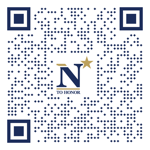
The "category" links below lead to lists of related Honorees; use them to explore further the service and sacrifice of alumni in Memorial Hall.
